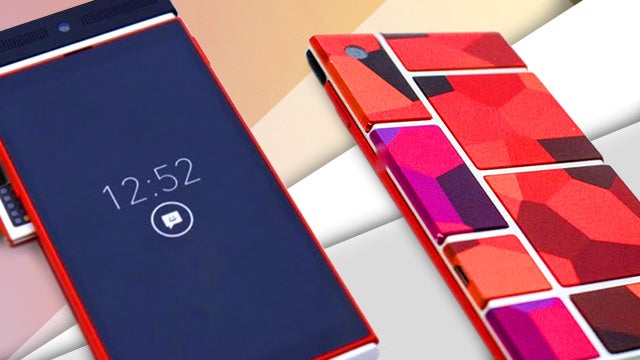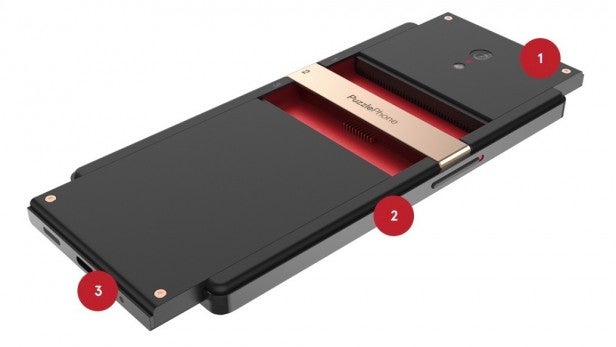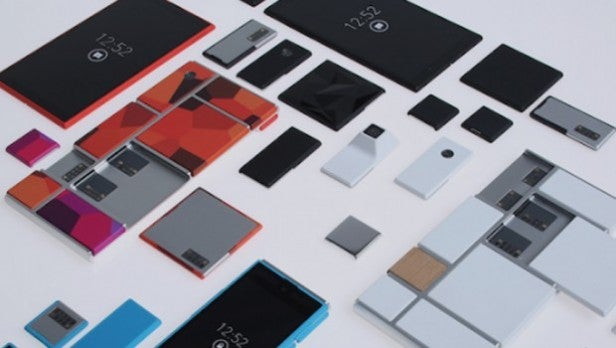Are modular phones the future, or doomed to fail?

As the smartphone market hits a bit of a lull, many are looking around for the next big innovation. Could modular phones be the next big thing?
The Samsung Galaxy S7, HTC 10, and iPhone 6S are all great phones. Each has a beautiful display, a premium metal design, and a great camera. But none of them really offers anything meaningfully new that we didn’t have three years ago.
It leads to one inescapable conclusion: the smartphone form factor as we know it has peaked.
Some ways have been suggested for manufacturers to take things to the next level, and arguably the most fully formed of those is the concept of modular phones.
So are modular phones the future?
What are modular phones?
First things first: what are we talking about when we talk about modular phones?
Smartphones typically arrive fully formed – a single unit of glass, metal, and plastic. You can often specify varying storage capacities, colours, and even designs (at least in Motorola’s case). But they still arrive at your door functionally complete, and they only way they’ll really change from that point until the day you replace them is with a new OS.
The concept of modular phones offers the potential to change all that. A true modular phone would be assembled from a number of self-contained components that then snap together to form a complete phone. The camera, storage, and NFC modules would be interchangeable.
There are several modular phone concepts out there, with varying degrees of sophistication and at varying stages of development. Here are four key examples.

LG G5
The LG G5 is a notable example of a modular phone because it’s actually on the market. Not only that, but it’s a true flagship phone rather than an experimental prototype.
Unfortunately, its modular component is a little half-baked. The phone is fundamentally feature-complete, but you can push a button to remove the bottom section of the phone (along with the battery) and replace it with one of a couple of ‘Friends’ that give it additional functionality.
These Friends include a B&O DAC, which turns the LG G5 into a high-end digital music player, and a grip that makes it easier to use as camera whilst boosting the battery.
And, well, that’s it. For now, anyway.
We’re hoping to see more Friends introduced throughout the year, but even if more are added, the LG G5 is far from the ultimate example of the modular phone ideal. The screen, RAM, CPU, and camera are fixed components, and the core phone is still essentially a high-end device with a deeply unflexible price tag to match.
Indeed, the Friends themselves aren’t exactly cheap in isolation. The LG CAM Plus Module sets you back around £70 on Amazon right now, while the B&O DAC is an eye-watering £180.
We applaud the company’s risk-taking approach, but it’s back to the modular drawing board for LG.

Fairphone
Fairphone takes a very different approach to the whole modular concept. Here it’s done more in a bid to promote transparency with regard to how such devices are made.
As the name suggests, these are ethically sourced phones (the Dutch startup behind them is onto its second phone now), where every stand-alone component is accounted for and priced.
It’s a worthwhile cause, but the whole modular thing isn’t a core function as such. It means you can change the back cover and repair the phone relatively easily with a new camera, display, or pretty much any other component. However, you’ll need a screwdriver to access most of them, which has led some to question the design’s true modularity.
Also, just like coffee and meat, ‘ethically sourced’ means pricey. The Fairphone 2 costs around €525, which works out to a little over £400. That’s still a good deal cheaper than your average flagship phone, but the Fairphone 2 isn’t a flagship phone. Not even close.
In fact, with a 5-inch Full HD display, a Snapdragon 801 processor, 2GB of RAM, 32GB of storage, and an 8-megapixel camera, it’s mid-range at best.
Still, aside from its status as a true modular phone, the move towards a more socially conscious (and readily repairable) kind of smartphone design should be applauded. If you’re interested, you can buy a Fairphone 2 direct from the Fairphone website.

PuzzlePhone
The PuzzlePhone is one of the most interesting and elegantly workable modular phone concepts we’ve seen.
It operates on a simple three-part system that includes a spine (the framework and display), a brain (all the internals and camera), and a heart (the battery and any extra functions). These can be replaced or upgraded in seconds thanks to the intuitive way they slide together.
Unfortunately, the PuzzlePhone didn’t even manage to attract half of its $250,000 IndieGoGo crowdfunding goal back in December.
Still, this money was merely for the production of the handsets. All of the R&D work has apparently been done by the Finnish startup behind the PuzzlePhone, and that process has been detailed on the company’s website. The project still appears to be active, with the last post on the company blog dated April 8 and speaking of how the company intends to “drive the design forward”.
There are no specifics on when we might be likely to see final PuzzlePhone units available to buy, though. It’s perhaps best not to hold your breath with this one, despite the good work that’s gone into its conception.

Project Ara
The most promising modular phones concept of them all is Google’s Project Ara.
First established by Google in 2013, Project Ara has been developed within its secretive Advanced Technology and Projects division.
The idea is to treat virtually every major component of a smartphone as a separate module that can be swapped out for another. Different manufacturers will be able to provide these specific-use components, leading to an app-like ecosystem of hardware customisation.
Each Project Ara device is built around an ‘endo’ – the framework around which you build your phone. You then snap in components like Lego. Cameras, RAM, processors, storage, NFC, and more.
The whole ‘app ecosystem’ idea could lead to far greater innovation and specialisation than we’ve seen with today’s generic one-size-fits-all phones. For example, those in developing countries might want to fit their Project Ara phone out with a module that tests a water source for purity, while people in developed countries might just want a state-of-the-art camera.
So where is Google at with this hugely promising project? It’s tough to tell. The radio silence has been deafening in recent months, following a protracted string of regional tests and delays (it seems early models didn’t much like being dropped). But towards the end of March, the Project Ara website received a makeover, encouraging hope for a Google I/O update in mid-May.
Just like cars and the internet, the future of modular phones could well be in the hands of the big G.
Related: What is Project Ara?
OPINION: Why modular phones could be great
TrusedReviews’ Joe Roberts argues that modular phones are indeed something to look forward to
The guys over at iFixit perhaps put it best: “It’s fun to take stuff apart. It’s interesting to see what’s inside that magic iPod you carry around every day. It’s gratifying to fix it with your own hands. Don’t believe us? Try it!” We’re not sure about the magic iPod part, but there is certainly something to be said for repairing something yourself – or at least having the option to do so.
The main drawback to modular phones thus far has been the aesthetics. The LG G5 is a nice-looking handset but, as we mentioned earlier, it’s not really a truly modular design. The only other modular phone currently available, the Fairphone 2, looks like something some amateur engineer threw together in his garage as a proof of concept. Then incinerated when he realised no one would give him any money for it.
It may seem somewhat trivial to be concerned with how your phone looks but the connection between style and substance is, and always has been, absolute. And a great idea for a phone, poorly designed, makes for a poor device. In other words, these phones are going to have to up their game when it comes to design if they ever want to grab people’s attention.

Which doesn’t seem like a wholly impossible task. If a modular phone arrives that can rival the look of the Galaxy S7, why wouldn’t you want the option to repair it yourself? Why not have the option to change the battery once it starts struggling to hold its charge properly? When it comes to software, the more developers lock down their operating systems, the more we decry the lack of openness. Why are we happy to overlook such a closed system when it comes to hardware?
One of the reasons many prefer Android over iOS is the control you have over the files on your handset. Plug your Android device into your computer and you can pretty much see and edit everything on your phone. There’s no specific software required to transfer files between phone and computer, no specific files which you can access without being able to see others. It’s a great system.
It seems obvious then, that many value a certain level of access to the things we shell out these large amounts for. Perhaps it’s time we apply that kind of mentality to the hardware side of things, and see if we can’t prompt these companies to give us a stylish modular handset. LG’s already started the process off, but we need something that goes all the way when it comes to modularity and design flair.
If we can get to that point, there seems to be no good reason why you would reject the ability to dismantle and repair your phone yourself rather than sending it off to the manufacturer and waiting weeks for it to return whenever it breaks. After all, in the noble words of the iFixit guys, it’s fun to take stuff apart.
OPINION: Modular phones, in their current state, are doomed
TrusedReviews’ Max Parker argues that modular phones are a long way off being truly useful
The idea of modular phones is great. I’m not doubting that, but nothing I have seen so far convinces me that I want one.
The LG G5 is the perfect example of this. With its release, LG had the chance to really push the modular idea with some exciting add-ons that people could make use of.
What did it come out with? An expensive DAC and an almost useless camera grip that doesn’t do anything except boost the battery a smidgen and give you a physical shutter button. There’s also, still, no sign of anyone else making these ‘Friends’, and that phone has been on shelves for a few weeks now.

Price is the real factor putting me off these modular devices. Take the Fairphone 2, for example. It’ll initially set you back about £450, pricey for a phone of this quality, but still cheaper than nearly all the flagships. Fairphone likes to say that you’ll keep this phone for five years, so really you’re going to be saving money. But unless you’re never going to invest in a new module, defeating the point entirely, you’ll end up splashing more cash over the years for extra bits. A new core module, the part that houses the CPU, currently costs 340 euros. For that price you could buy the latest Moto G each year and still save some money.
What modular phones really need to take off is for a standard so the bits and pieces will work across devices, and I don’t think that will ever happen. The other way modular phones will take off is, and this isn’t in anyway me being a ‘fanboy’, if Apple make one. You’d instantly have the third parties on side (just think of all the Apple add-ons you can buy now) and that’s important.
Modular phones just haven’t excited me yet, and it’s going to take something for them to.
(apester:56fa56328eda0b1e58c43aa6)
What do you think?
We’ve had our say, now have yours. Let us know in the comments box below whether you think module phones are the future, or something that will quickly be forgotten about.


